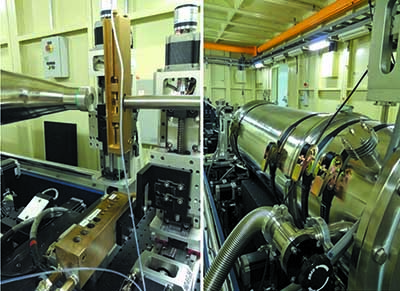The BioSAXS beamline at the Shanghai Synchrotron Radiation Facility
 The new
biological small-angle X-ray scattering (BioSAXS) beamline (BL19U2) at the
Shanghai Synchrotron Radiation Facility (SSRF) is the first facility in China
dedicated exclusively to SAXS experiments on biological macromolecules in
solution. It took three years
to carry out the major renovation, eventually pilot runs of the beamline began
in September 2014 and it was officially opened to users in March 2015 [Xiuhong et al. (2016). J. Appl. Cryst. 49. doi:10.1107/S160057671601195X]. Because the beamline was designed
specifically for biological macromolecule studies, an automated sample
changer was installed for reliable SAXS experiments in solution. The electrons come from an
undulator which can provide high brilliance for the BL19U2 end stations. Access to the beamline is either through the
NCPSS [National Center for Protein Sciences Shanghai] beamtime application system (http://www.ncpss.org/userGuideInfo.action) or through a rolling application
system which accepts proposals at any time.
The new
biological small-angle X-ray scattering (BioSAXS) beamline (BL19U2) at the
Shanghai Synchrotron Radiation Facility (SSRF) is the first facility in China
dedicated exclusively to SAXS experiments on biological macromolecules in
solution. It took three years
to carry out the major renovation, eventually pilot runs of the beamline began
in September 2014 and it was officially opened to users in March 2015 [Xiuhong et al. (2016). J. Appl. Cryst. 49. doi:10.1107/S160057671601195X]. Because the beamline was designed
specifically for biological macromolecule studies, an automated sample
changer was installed for reliable SAXS experiments in solution. The electrons come from an
undulator which can provide high brilliance for the BL19U2 end stations. Access to the beamline is either through the
NCPSS [National Center for Protein Sciences Shanghai] beamtime application system (http://www.ncpss.org/userGuideInfo.action) or through a rolling application
system which accepts proposals at any time.
The experimental hutch contains a 9.2 m long metal table which supports the experimental hutch equipment. The table has a cavity in the middle, in which four motorised supporting platforms were installed to facilitate the changing of the flight tube length. The flight tube itself is a modular design for variable length and is mounted on motorised supporting platforms.
To meet the rapidly growing demands of crystallographers, biochemists and structural biologists, the BioSAXS beamline allows manual and automatic sample loading/unloading. It has the capability to perform up to 100 data collections on liquid protein samples per day with a correspondingly high level of automation. A Pilatus 1M detector (Dectris) is employed for data collection, characterised by a high dynamic range and a short readout time. The highly automated data processing pipeline SASFLOW was integrated into BL19U2, which provides a user-friendly interface for data processing.
To ensure the competitiveness of the BioSAXS facility at the SSRF, future development will be focused on a variety of sample exposure environments for solution SAXS experiments, for example, reducing the sample volumes required for a single SAXS measurement and exploring the possibility of integrating a size-exclusion column in to the beamline.
To date, feedback from users has been positive and the number of experimental proposals at BL19U2 is increasing. Turning thoughts to further improvements in the field of SAXS data collecting detectors, the development of a time-resolved on-site device is on the horizon.


